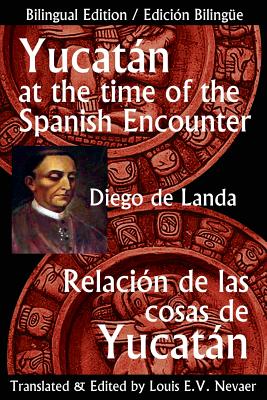
Yucatan at the Time of the Spanish Encounter: Relacion de Las Cosas de Yucatan
Paperback
AnthropologyMexicoMexican History
Publisher Price: $18.95
ISBN13: 9781939879028
Publisher: Hispanic Economics
Published: May 15 2013
Pages: 300
Weight: 0.97
Height: 0.67 Width: 6.00 Depth: 9.00
Language: Multiple Languages
Also in
Mexican History
Paradise of the Damned: The True Story of an Obsessive Quest for El Dorado, the Legendary City of Gold
Thomson, Keith
Hardcover
Historia de México: Una guía fascinante de la historia de México y la Revolución Mexicana
History, Captivating
Paperback
Forget the Alamo: The Rise and Fall of an American Myth
Burrough, Bryan
Tomlinson, Chris
Stanford, Jason
Paperback
Chicano Bakes: Recipes for Mexican Pan Dulce, Tamales, and My Favorite Desserts
Castillo, Esteban
Hardcover
The Last Emperor of Mexico: The Dramatic Story of the Habsburg Archduke Who Created a Kingdom in the New World
Shawcross, Edward
Paperback
The Wheel of Time: The Shamans of Mexico Their Thoughts about Life Death and the Universe
Castaneda, Carlos
Paperback
Down & Delirious in Mexico City: The Aztec Metropolis in the Twenty-First Century
Hernandez, Daniel
Paperback
Mexico - Culture Smart!: The Essential Guide to Customs & Culture
Culture Smart!
Maddicks, Russell
Paperback
Historia de México: 1000 datos interesantes desde la antigüedad hasta nuestros días
Publications, Ahoy
Paperback
An Inquiry Into the Origin of the Antiquities of America.
Delafield, John 1812-1866
Lakey, James
Paperback
When Montezuma Met Cortés: The True Story of the Meeting That Changed History
Restall, Matthew
Paperback
Studies of the Yaqui Indians of Sonora, Mexico: The History, Culture and Anthropology of the Yaqui Native Americans
Holden, William Curry
Paperback
Aztec Thought and Culture: A Study of the Ancient Nahuatl Mindvolume 67
León-Portilla, Miguel
Paperback
South to Freedom: Runaway Slaves to Mexico and the Road to the Civil War
Baumgartner, Alice L.
Paperback
Historia, tradiciones y leyendas de calles de Mexico. Tomo I: Prologo de Jerman Argueta
de Valle-Arizpe, Artemio
Paperback
In the Shadow of Quetzalcoatl: Zelia Nuttall and the Search for Mexico's Ancient Civilizations
Grindle, Merilee
Hardcover
El Mito de Las Tres Transformaciones / The Myth of Mexico's Three Transformations
Zunzunegui, Juan Miguel
Paperback
Mesoamerican History: A Captivating Guide to Four Ancient Civilizations that Existed in Mexico - The Olmec, Zapotec, Maya and Aztec Civilization
History, Captivating
Hardcover
Between Black and Brown: Blaxicans and Multiraciality in Comparative Historical Perspective
Daniel, G. Reginald
Romo, Rebecca
Sterphone, J.
Paperback
Mexican History: A Captivating Guide to the History of Mexico and the Mexican Revolution
History, Captivating
Paperback
Fear Is Just a Word: A Missing Daughter, a Violent Cartel, and a Mother's Quest for Vengeance
Ahmed, Azam
Hardcover
La Tiranía de Las Ideas. Lo Que Necesitas Para Comprender a México, Estados Unid O S, La Humanidad Y El Mundo. / The Tyranny of Ideas
Zunzunegui, Juan Miguel
Paperback
Indigenous Sacraments: Christian Rituals and Local Responses at the Fringes of Spanish America, 1529-1800
Ambrogio Gali, Oriol
Hardcover
Mezcal: The History, Craft & Cocktails of the World's Ultimate Artisanal Spirit
Janzen, Emma
Hardcover
History of Mexico: A Captivating Guide to Mexican History, Starting from the Rise of Tenochtitlan through Maximilian's Empire to the Mexi
History, Captivating
Paperback
The Aztec Empire: An Enthralling Overview of the History of the Aztecs, Starting with the Settlement in the Valley of Mexico
History, Enthralling
Hardcover
Colonizing Ourselves: Tejano Back-To-Mexico Movements and the Making of a Settler Colonial Nation Volume 5
Hernández, José Angel
Hardcover
La historia de México: Una Guía Fascinante de la Historia Mexicana, Desde el Ascenso de Tenochtitlan y el Imperio de Maximiliano hasta la Rev
History, Captivating
Hardcover
Making Mexican Rock: Censorship, Journalism, and Popular Music After Avándaro
Green, Andrew J.
Paperback
Nuño de Guzmán: Juicio de residencia en Nueva Galicia, 1537-1538
Regalado Pinedo, Aristarco
Paperback
History of Mexico: A Captivating Guide to Mexican History, Starting from the Rise of Tenochtitlan through Maximilian's Empire to the Mexi
History, Captivating
Hardcover
La historia de México: Una Guía Fascinante de la Historia Mexicana, Desde el Ascenso de Tenochtitlan y el Imperio de Maximiliano hasta la Rev
History, Captivating
Paperback
Between Here and There: Creating the Political Economy of Mexican Migration, 1900-1942
Morales, Daniel
Paperback
Suerte O Desastre: El Azar Como Modelo Económico de Amlo / Luck or Disaster. Cha Nce as Amlo's Economic Model
Cota, Isabella
Paperback
Mexican History: A Captivating Guide to the History of Mexico and the Mexican Revolution
History, Captivating
Hardcover
Haciendas del Altiplano. Historia(s) y leyendas.: Tomo II. De la Independencia a la Revolución
Adame, Homero
Paperback
The Forgotten Diaspora: Mesoamerican Migrations and the Making of the U.S.-Mexico Borderlands
Jeffres, Travis
Hardcover
Confesiones Desde El Exilio: Enrique Peña Nieto / Confessions from Exile: Enrique Peña Nieto
Maldonado, Mario
Paperback
An Outpost of Colonialism: The Hispanic Community of Mérida, Yucatán, 1690-1730
Patch, Robert W.
Hardcover
México's Nobodies: The Cultural Legacy of the Soldadera and Afro-Mexican Women
Arce, B. Christine
Paperback
Landscaping Indigenous Mexico: The Liberal State and Capitalism in the Purépecha Highlands
Pérez-Montesinos, Fernando
Hardcover
100 Mitos de la Historia de México 1 / 100 Myths of the History of Mexico 1
Martín Moreno, Francisco
Paperback
Mexico's Resilient Journalists: How Reporters Manage Risk and Cope with Violence
Brambila, Julieta
Paperback
Seeds of Empire: Cotton, Slavery, and the Transformation of the Texas Borderlands, 1800-1850
Torget, Andrew J.
Paperback
Antiguas Civilizaciones: Una Fascinante Guía sobre la Historia de los Mayas, Aztecas y el Imperio Inca
History, Captivating
Hardcover
Texas History Stories: The Alamo, the Goliad Massacre, San Jacinto and Biographies of Sam Houston, David Crockett, Dick Dowling and Other Heroes
Littlejohn, Elbridge Gerry
Paperback
An Inquiry Into the Origin of the Antiquities of America.
Delafield, John 1812-1866
Lakey, James
Hardcover
The End of Catholic Mexico: Causes and Consequences of the Mexican Reforma (1855-1861)
Gilbert, David
Paperback
The Last Emperor of Mexico: The Dramatic Story of the Habsburg Archduke Who Created a Kingdom in the New World
Shawcross, Edward
Hardcover
The General and the Jaguar: Pershing's Hunt for Pancho Villa: A True Story of Revolution and Revenge
Welsome, Eileen
Paperback
Midnight in Mexico: A Reporter's Journey Through a Country's Descent into Darkness
Corchado, Alfredo
Paperback
The Zapatistas' Dignified Rage: Final Public Speeches of Subcommander Marcos
Marcos, Subcomandante Insurgente
Paperback
A Brief Account of the Destruction of the Indies, Or, a Faithful Narrative of the Horrid and Unexampled Massacres Committed by the Popish Spanish Pa
de Las Casas, Bartolome
Hardcover
Antiguas Civilizaciones: Una Fascinante Guía sobre la Historia de los Mayas, Aztecas y el Imperio Inca (Libro en Español/Ancient Civilizations
History, Captivating
Paperback
La Conquista Para Gente Con Prisa / The Conquest for People in a Hurry
Cuauhtémoc, Tlatoani
Paperback
Child Martyrs and Militant Evangelization in New Spain: Missionary Narratives, Nahua Perspectives
Schmidt, Stephanie
Hardcover
It Happened in New Mexico: Stories of Events and People That Shaped the Land of Enchantment
Crutchfield, James A.
Paperback
Between Black and Brown: Blaxicans and Multiraciality in Comparative Historical Perspective
Romo, Rebecca
Sterphone, J.
Daniel, G. Reginald
Hardcover
River of Hope: Forging Identity and Nation in the Rio Grande Borderlands
Valerio-Jiménez, Omar S.
Paperback
A Continuous State of War: Empire Building and Race Making in the Civil War-Era Gulf South
Diaz, Maria Angela
Paperback
El dragon y la ceiba. Chinos en el pais de los mayas. Siglos XIX a XX
Ramirez Carrillo, Luis Alfonso
Paperback
Dancing on the Sun Stone: Mexican Women and the Gendered Politics of Octavio Paz
Becker, Marjorie
Paperback
Cartels at War: Mexico's Drug-Fueled Violence and the Threat to U.S. National Security
Kan, Paul Rexton
McCaffrey, Barry R.
Hardcover
The Mexican Revolution: A Captivating Guide to the Mexican Civil War and How Pancho Villa and Emiliano Zapata Impacted Mexico
History, Captivating
Hardcover
The Banana Wars: A Captivating Guide to the Interventions of the United States in Central America, Mexico, and the Caribbean
History, Captivating
Hardcover
A Narco History: How the United States and Mexico Jointly Created the Mexican Drug War
Wallace, Mike
Boullosa, Carmen
Paperback
The True History of the Conquest of New Spain: The Memoirs of the Conquistador Bernal Diaz del Castillo, Unabridged Edition Vol.1-2
Diaz del Castillo, Bernal
Hardcover
Illusions of Empire: The Civil War and Reconstruction in the U.S.-Mexico Borderlands
Kiser, William S.
Hardcover
City on Fire: Technology, Social Change, and the Hazards of Progress in Mexico City, 1860-1910
Alexander, Anna Rose
Paperback
Rebel Mexico: Student Unrest and Authoritarian Political Culture During the Long Sixties
Pensado, Jaime M.
Paperback
Las DOS Izquierdas: Lo Que Nunca Se Contó Sobre La Izquierda Mexicana / The Two Lefts: What Has Never Been Told about the Mexican Left
G. Castañeda, Jorge
Ortega Juárez, Joel
Paperback
The Great Book of Mexico: Interesting Stories, Mexican History & Random Facts About Mexico
O'Neill, Bill
Paperback
Making Mexican Rock: Censorship, Journalism, and Popular Music After Avándaro
Green, Andrew J.
Hardcover
La Revolución mexicana: Una guía fascinante sobre la guerra civil mexicana y cómo Pancho Villa y Emiliano Zapata tuvieron un impacto en México
History, Captivating
Hardcover


 Sign-In
Sign-In Cart
Cart